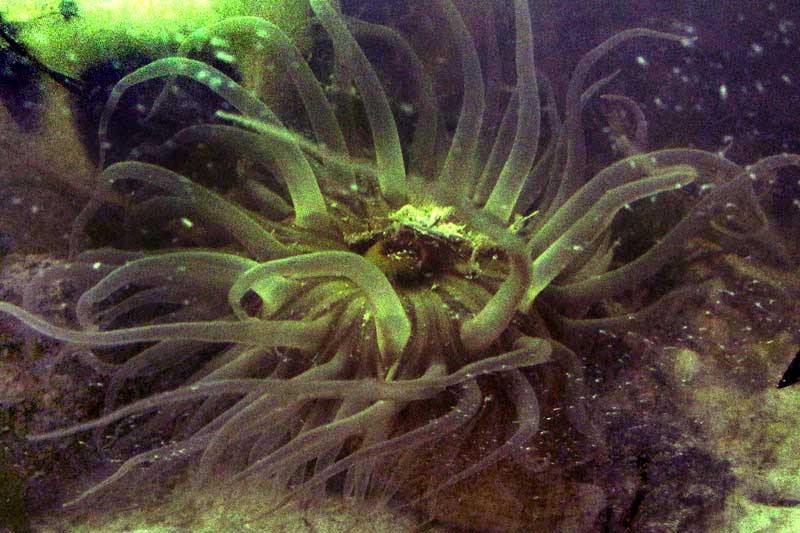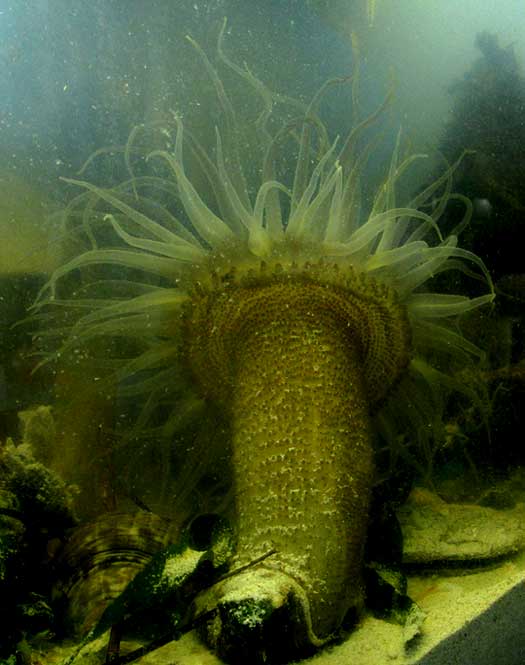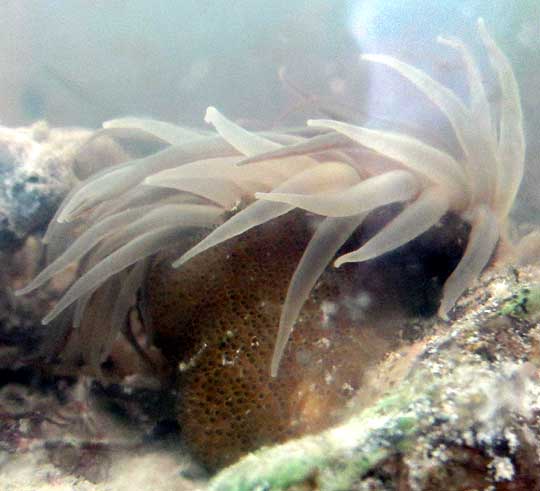Excerpts from Jim Conrad's
Naturalist Newsletter

from the March 22, 2015 Newsletter issued from Río Lagartos, on the Yucatan Peninsula's northern coast (~N21.60°, ~W88.16°), Yucatán state, MÉXICO
BROWN GLASS ANEMONE
One morning about a month ago during a very low tide Rayo spotted something interesting in the mud between stranded boats at the dock. That was when we were putting the aquarium together and looking for things to put in it, so he gave his discovery a new home there. At first the organism was just a small, brown, squishy blob, but after it'd settled down it astonished everyone by sprouting slowly waving, worm-like tentacles, as shown at the top of this page.
Our creature was a sea anemone, so in the picture the low, crater-like structure in the center of the tentacles is both the creature's mouth and anus. Prey such as small fish and shrimp are pulled into the opening by the tentacles, the food is digested in the stomach-like "gastrovascular cavity," and the remains are ejected through the same opening.
A few days later our sea anemone amazed us even more by developing a stout trunk below the tentacles, making it about three inches tall (8cm), shown below:

The creature didn't always remain treelike. Sometimes it'd shorten its trunk and pucker its tentacles, as shown below in a photo taken a few days after the above one:

Sea anemones are water-dwelling, predatory animals of the Order Cnidaria, which besides sea anemones incorporates corals, jellyfish, hydras and such. Animals in this order, called cnidarians, are radially symmetrical and their mouths are surrounded by tentacles bearing explosive cells known at "nematocytes," which can shoot out microscopic, poison-dart-like "cnidae." Tentacles coming into contact with prey shoot their cnidae into it, then slowly, weakly but persistently conduct the stunned or killed prey into the mouth.
Over 10,000 Cnidaria species are known, all aquatic and mostly marine, so here along the Yucatan coast cnidarians are worth knowing about.
None of the usual websites helping with identification of organisms of the Gulf of Mexico, Caribbean or Yucatan showed or mentioned a sea anemone like ours. After several weeks of trying to identify it I wondered if we might have a species not yet known to science. In one last effort, however, I contacted Karen Sanamyan in Russia, co-producer of the excellent Actiniaria.com website dedicated just to sea anemones and their kin.
Karen was unfamiliar with our species but in passing he pointed out its similarity to Aiptasia pallida. When I looked up that species, pictures of it on the Internet more closely matched our aquarium species than any others I'd seen. In fact, surely our sea anemone is a member of the genus Aiptasia, which on Wikipedia is described as "... a widely distributed genus of temperate and tropical sea anemones of benthic lifestyle typically found living on mangrove roots and hard substrates." That fits us perfectly, the term "benthic" referring to the ecological region at an ocean's or lake's bottom.
In the genus Aiptasia, which currently embraces 17 species, the most commonly occurring and best known species is Aiptasia pallida, whose pictures look like our animal. Therefore, even though I can't be sure, I'm filing our aquarium occupant under the name AIPTASIA PALLIDA, sometimes known as the Brown Glass Anemone. Aiptasia pallida is distributed along the entire Atlantic coast of the US, south across the Gulf of Mexico and throughout the Caribbean.
Despite Aiptasia pallida not appearing on the usual identification web pages, the species enjoys a certain fame. One reason is that aquarium hobbyists regard the species as a pest, because its powerful nematocytes can kill other aquarium occupants. Also, Aiptasia pallida can reproduce so prodigiously that its offspring take over the aquarium. The species also is famous because it's been chosen by scientists as a study organism in their efforts to understand the problem of coral bleaching. Coral bleaching is when stressful conditions of temperature, light, or nutrients cause corals to expel the symbiotic algae living in their tissues, causing them to turn completely white. Without the algae, the coral eventually dies.
One reason Aiptasia pallida was chosen for the study of coral bleaching is that the creature's brown color is caused by an alga, Symbiodinium microadriaticum, which lives symbiotically within the anemone's tissues the same way algae lives in the tissue of reef-building corals. These microscopic algal cells photosynthesize carbohydrates which the sea anemone uses as food, and in return the sea anemone provides the algal cells with a home.
Aiptasia pallida mostly reproduces asexually by fragmentation, but sometimes it has sex, with individuals being either male and female. During mating season, ova and sperm are released into the water, fertilization takes place there, and the fertilized ova develop into microscopic larvae called planulae. The planulae settle onto many kinds of substrates and develop into new sea anemones.